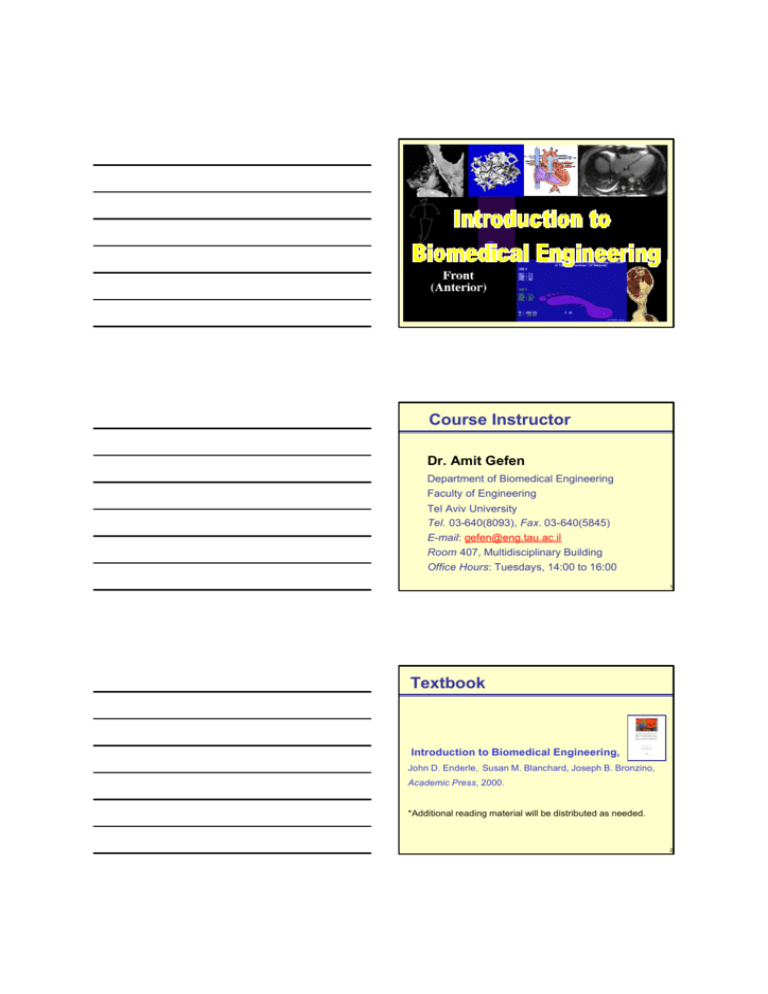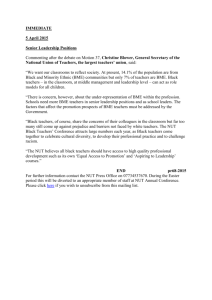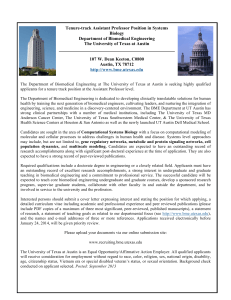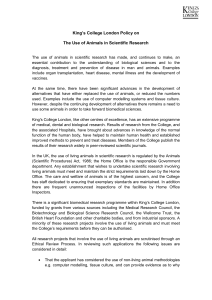PDF file of PowerPoint Presentation
advertisement

Course Instructor Dr. Amit Gefen Department of Biomedical Engineering Faculty of Engineering Tel Aviv University Tel. 03-640(8093), Fax. 03-640(5845) E-mail: gefen@eng.tau.ac.il Room 407, Multidisciplinary Building Office Hours: Tuesdays, 14:00 to 16:00 1 Textbook Introduction to Biomedical Engineering, John D. Enderle, Susan M. Blanchard, Joseph B. Bronzino, Academic Press, 2000. *Additional reading material will be distributed as needed. 2 Course Objectives This course is an introduction to the central topics of Biomedical Engineering (BME), emphasizing the principles of -problem definition (clinical need) -development of the field of BME and important inventions -information access and retrieval, scientific communication -clinical engineering and industrial activity -ethics and social responsibility of biomedical engineers 3 Course Objectives (cont.) The lecturers taking part in this course are faculty members at the Department of Biomedical Engineering, Senior Physicians or Industrial Leaders in BME Each of them will present a lecture on some of his research topics or activities. By meeting the members of the Dept. of BME, listening to them and reading the lecture notes and relevant textbook material, you will get an idea about their personal interests and achievements 4 Course Objectives (cont.) An important objective of this course is to let you learn a little bit about what a bioengineer is expected to do and to behave in the industry, hospital and academia Overall, you will get a feeling about Biomedical Engineering as a DISCIPLINE 5 Specific Course Objectives -define commonly used terms from Medicine and BME -describe common mechanical, electrical and chemical signals that emanate from the body (e.g. ECG, BP, respiratory signals, biomechanical forces etc.) and how they are measured -describe the engineering principles of common medical devices (e.g., artificial joints, limbs, organs, and valves, stents, CT scanners, diagnostic ultrasound). -provide skills for searching scientific literature and for retrieval of articles on specific topics -provide skills for searching the World Wide Web (WWW) for articles, images, videos and other biomedical resources. 6 Contents of the Course 1. Overview on the Fields of Biomedical Engineering (Dr. A. Gefen) 2. Retrieval and Editing of Biomedical -Related Information (Dr. A. Gefen) 3. Biological Signals: Origin, Measurement and Processing (Prof. O. Barnea) 4. Medical Imaging (Prof. S. Abboud) 5. Telemedicine and Home- Care (Prof. S. Abboud) 6. Biomechanics of the Cardiovascular System (Prof. S. Einav) 7. Musculoskeletal Biomechanics (Dr. A. Gefen) 8. Biomechanics of the Respiratory System (Prof. D. Elad) 9. Bio-nano-technology and Tissue Engineering (Prof. S. Einav) 10. Medical Optics (Dr. I. Gannot) 11. Medical Image Processing (Dr. H. Greenspan) 12. Biomedical Engineering in the Clinical Setting (Dr. P. Halpern) 13. Artificial Tissues and Organs (Prof. D. Elad) 14. The Israeli Biomedical Engineering Industry (Panel of Representatives) 7 Major Advances in BME according to the Whitaker Foundation, aimed to promote better human health through advancements in medicine and rehabilitation 1. Hip Joint Replacement surgical procedure 8 Major Advances in BME (cont.) 2. Magnetic Resonance Imaging MR imaging of the contractile motion of the human heart 9 Major Advances in BME (cont.) 3. Heart Pacemaker 10 Major Advances in BME (cont.) 4. Arthroscopy 11 Major Advances in BME (cont.) 5. Heart-Lung Machine 1955, Mayo Clinic, USA Modern Heart-Lung Machine 12 Major Advances in BME (cont.) 6. Angioplasty 13 Major Advances in BME (cont.) 7. Bioengineered Skin 14 Major Advances in BME (cont.) 8. Timed-Release Drug Capsules 15 Major Advances in BME (cont.) 9. Artificial Articulated Joint surgical procedure 16 Major Advances in BME (cont.) 10. Kidney Dialysis 17 18 Early History of Medicine and BME Primitive healers drilled holes in skulls to gain access to brain - patients (sometimes) survived. Based on interrelationships between supernatural and health. Egypt, 3000 BC - concepts and practices recorded on papyri and stored in tombs. Recorded observations and results. 19 Early History of Medicine (Cont.) Antiquity (650 BC - 200 AD) Aesculapius - Greek god of healing. Son of Apollo. May have been based on a real person. By 1000 BC, Aesculapia, temples of the healing cult, were among the first hospitals. Hippocrates - 460?-370? BC. Collector of remedies and techniques that existed up to his time. Began to replace superstition with diagnostic observation and clinical treatment. Disease - natural process. 20 Early History of Medicine (Cont.) Antiquity (650 BC - 200 AD) Romans - contributed to public health with sewer systems and aqueducts. Army medical service. Galen - 130?-200? AD. A Greek who was the greatest physician in the history of Rome. Wrote more than 300 books of anatomical observations. Misleading anatomy based on animal dissections. Evolution of modern hospital began with rise of Christianity. Major contribution of monasteries. 21 Early History of Medicine (Cont.) Antiquity (650 BC - 200 AD) - Medieval Ages (200 1450) Constantine I (335 AD) closed all pagan temples of healing and established hospitals in every cathedral city. Houses for travelers and sick. Church became repository of medical information when Roman Empire collapsed. Medical research stagnated for almost 1000 years (Dark Ages: 476 AD - end of 10th century). Hospital system spread during Crusades, end of 11th to end of 13th century. Most were custodial institutions. Institution to be feared and shunned. 22 Early History of Medicine (Cont.) Medieval Ages (200 1450) scientific development decreased, as religious and spiritual developments increased Arab scholars the scientific investigations of antiquity from disappearing by translating works from Greek to Arabic. Capillary Blood Flow: . . . the arteries of the whole body Moses Maimonides 1135-1204 have openings communicating with veins. They are taking blood and spirits (oxygen) from each other through narrow and hidden transits. [J. Royal College of Physicians of London, 29: 361-3, 1995] 23 Early History of Medicine (Cont.) Renaissance (1450 1600) Renaissance and Reformation - 15th and 16th centuries. Study of human anatomy advanced by artists: Michelangelo, Durer, Vesalius and da Vinci. Leonardo da Vinci (1452- 1519) 24 Leonardo da Vinci (1452-1519) Italian Renaissance 25 Leonardo da Vinci (1452-1519) Italian Renaissance 26 Leonardo da Vinci (1452-1519) Italian Renaissance 27 Andreas Vesalius (1514-1564) Italian Renaissance 28 Early History of Medicine (Cont.) Renaissance (1450 1600) Henry VIII - King of England, 1509-1547. Supported establishment of the College of Physicians, oldest purely medical institution in Europe. New medical schools - Salerno, Bologna, Montpelier, Padua, and Oxford. Embraced Hippocratic doctrine disease is a natural process. Galileo - visited Padua in 1592 and lectured on mathematics to medical students. Invented thermometer in 1596. Sanctorius - student of Galileo who made comparative studies of human temperature and pulse 29 Galileo Galilei (1564-1642) Scientific Revolution Early representation of skeletal structures using engineering terms 30 Early History of Medicine (Cont.) Renaissance (1450 1600) Urban centers began to expand. Two major hospitals in London, St. Bartholomew s (founded 1123, refounded in 1544) and St. Thomas, began a policy of admitting and attending to only those patients who could possibly be cured. 31 Early History of Medicine (Cont.) Scientific Revolution (1690-1730) William Harvey - graduated from Padua and applied Galileo s laws of motion and mechanics to problem of blood circulation. Announced discovery of blood circulation at St. Bartholomew s Hospital in London in 1619. Giovani Borelli applies structural engineering concepts to the description of the musculoskeletal system during different human and animal postures and movements 32 Giovani A. Borelli (1608-1679) Scientific Revolution 33 History of Medicine and BME Enlightenment (1730 1800) Development of the mechanical philosophy and specific research areas after definition of Newton s Laws. Focus on investigation of movement and motion. The mechanical philosophers of this period also include: Euler, d Alembert, Lagrange, Bernoulli. Philosopher/Scientist Dates Subject of Investigation Leonhard Euler 1707 -1783 Wave propagation in arteries Thomas Young 1773 -1829 Young's modulus of elasticity Jean Poiseuille 1799 -1869 Blood viscosity, Mercury manometer 34 History of Medicine and BME (Cont.) The 19 th Century Biology became diversified into specialized fields of study. Development of sport and leisure during the late 18th century renewed the scientific interest in human and animal locomotion. 35 History of Medicine and BME (Cont.) The 19 th Century Hospitals began to benefit patients in 1800s thanks to Florence Nightingale who introduced hygienic standards into military hospitals during Crimean War (1855). Imagine what would it have been like To have appendicitis before antibiotics and anesthesia? To have a broken bone set before X-rays? 36 History of Medicine and BME (Cont.) The 20 th Century The 20th century is characterized by technological developments resulting from two World Wars, increased population, interest in sport, and support of medical developments. Development of interdisciplinary research in Biomedical fields. Biomechanics became an independent discipline. Biomechanics lead to the development of Biomedical Engineering as a university field and academic degree. 37 History of Medicine and BME (Cont.) cinematographic studies of human motion under different environmental conditions, early 20th century 38 Changing Role of Hospitals 39 40 What is Biomedical Engineering? Biomedical Engineers apply electrical, chemical, optical, mechanical, and other engineering principles to understand, modify, or control biological systems. Involves more than development of medical devices. Interdisciplinary branch of engineering that is heavily based in both engineering and the life sciences. 41 Examples for Specialty Areas in BME Medical Instrumentation and Biosensors Biomedical Computational Analysis Biotechnology Biological Signal Analysis Medical Imaging Physiological Modeling Clinical Engineering Rehabilitation Engineering and Prosthetic Devices 42 Who is a Clinical Engineer ? An engineer who has graduated from an accredited academic program in engineering and is engaged in the application of scientific and technological knowledge developed through engineering education and subsequent professional experience within the health care environment in support of -direct patient care -maintenance and support of medical systems -research in the clinical setting -teaching in the clinical setting -public service activities for enhancing patient care 43 What is Rehabilitation Engineering ? The application of science and technology to ameliorate the handicaps of individuals with disabilities. * Many individuals who say that they practice rehabilitation engineering are not engineers by training. Rehabilitation (assistive) technology is the selection, design, or manufacture of assistive devices that are appropriate for an individual with a disability. 44 Rehabilitation Engineers (cont.) Work in a team setting in collaboration with physical and occupational therapists, orthopedic surgeons, physical medicine specialists, and/or neurologists. Some are concerned with activities of daily living. Others focus on mobility and limitations to mobility within a home or office or in the public arena. Others deal with sensory disabilities, e.g. sight or hearing, or with communications disorders. 45 Roles of Biomedical Engineers Problem Solvers - work on solving problems identified by life scientists, physicians, clinical engineers or biomedical design engineers. Must understand the biological situation. Technological entrepreneur - examines some portion of the medical or biological front and identifies areas in which the application of advanced technology can offer new solutions. Biomedical design engineers in industry: must market inventions to medical community 46 Roles of Biomedical Engineers (Cont.) Engineering Science - applies engineering concepts and techniques to the investigation and exploration of biological processes. Seeks new knowledge. Develop models and simulations. Usually found in industrial research labs and academic institutions. 47 Professional Societies - Objectives encourage international contacts amongst scientists promotes the distribution of knowledge by publication of -scientific peer reviewed journals -scientific magazines -proceedings of scientific meetings forms contacts with national organizations 48 Professional Societies IEEE EMBS IEEE Engineering in Medicine & Biology Society. Founded in 1952. Web Site: http://www.eng.unsw.edu.au/embs/index.html Publications The Society publishes the following Transactions and Magazine: -IEEE Transactions on Biomedical Engineering -IEEE Engineering in Medicine and Biology Magazine -IEEE Transactions on Rehabilitation Engineering -IEEE Transactions on Information Technology in Biomedicine In collaboration with other societies it also publishes: -IEEE Transactions on Medical Imaging -IEEE Transactions on Neural Networks -IEEE Transactions on Pattern Analysis and Machine Intelligence An International Conference is also taking place annually 49 Professional Societies (cont.) BMES Biomedical Engineering Society Founded in Illinois, 1968. Web Site: http://www.bmes.org/ The purpose of the society is: to promote the increase of biomedical engineering knowledge and its utilization" Publications Proceedings of BMES Conferences 50 Professional Societies (cont.) ISB The International Society of Biomechanics Founded in Penn State University, 1973 Web Site: http://www.isbweb.org/ The purpose of the society is: promote the study of all areas of biomechanics at the international level" Publications J. Clinical Biomech. Biomech. J. Electro -myography & Kinesiology J. Applied Biomech. Proc. of ISB biennial Congresses 51




